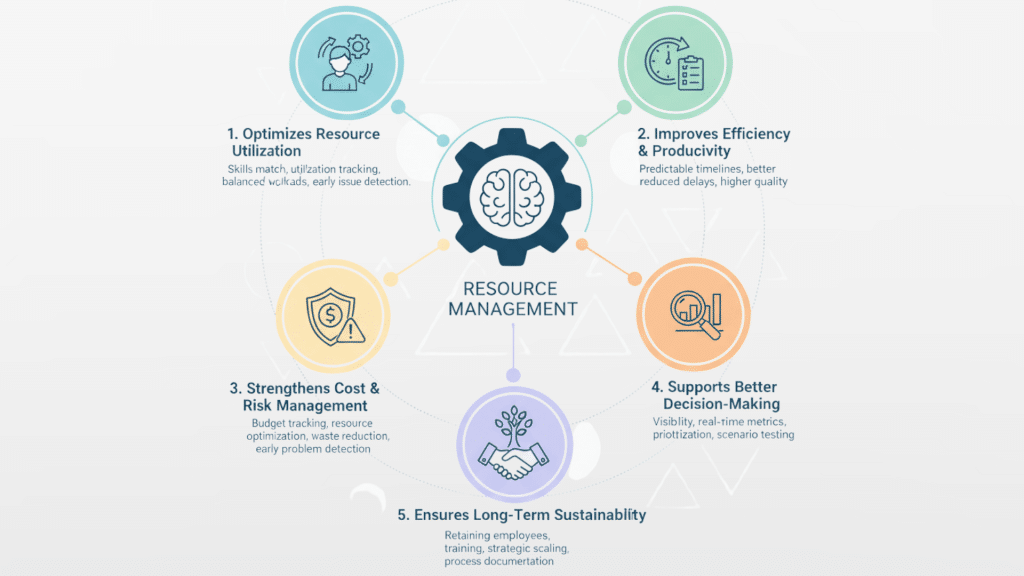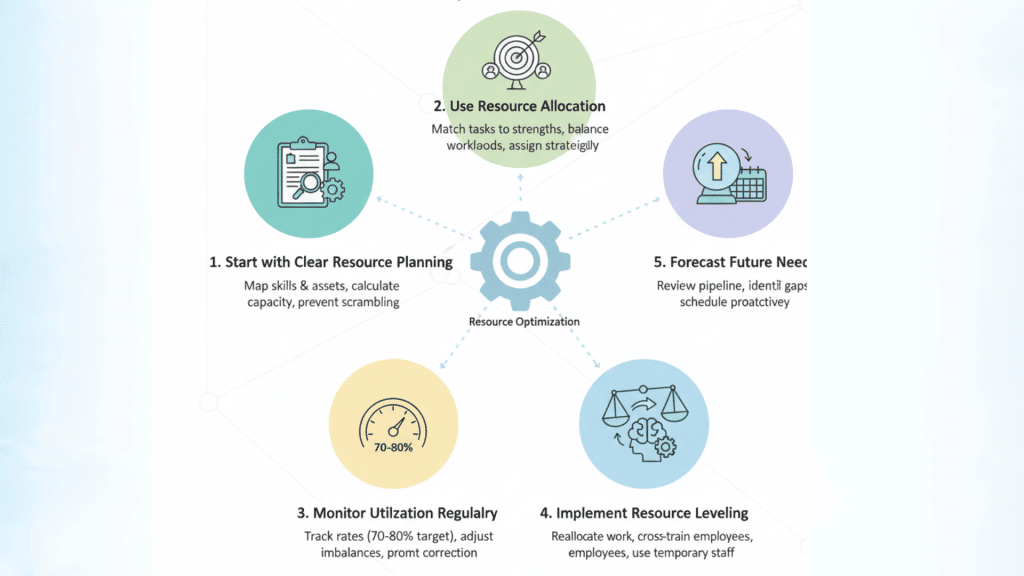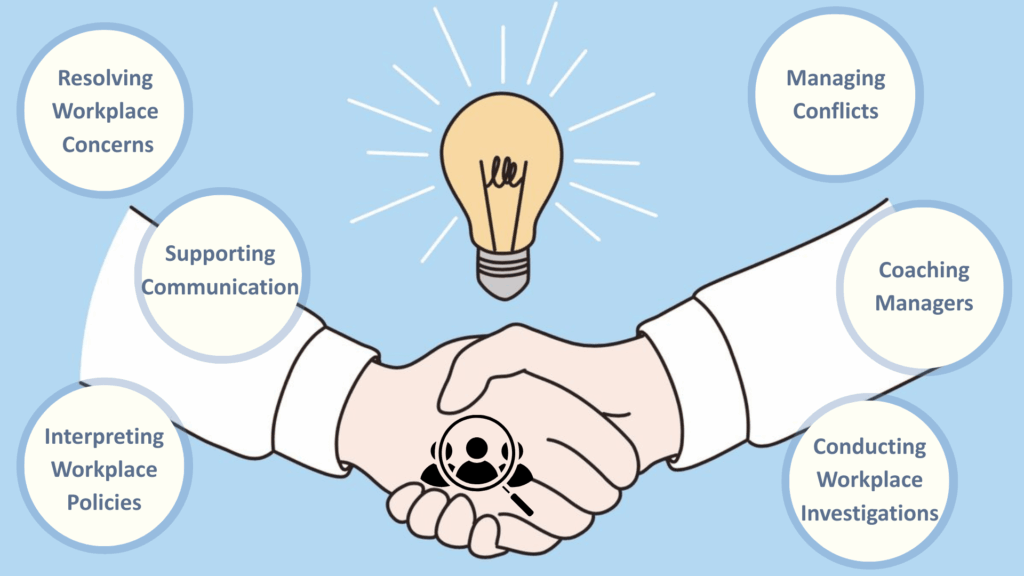Resource management is a critical practice for any business, ensuring that personnel, funds, technology, and time are allocated efficiently to meet project goals.
Without proper resource management, organizations face missed deadlines, overworked teams, and blown budgets, all of which can hinder long-term success.
Effective resource management not only streamlines operations but also fosters a productive work environment and reduces waste.
This blog emphasizes the significance of resource management, its influence on productivity, cost control, and informed decision-making, and its contribution to long-term business sustainability.
What is Resource Management?
Resource management is the process of planning, allocating, and monitoring time, money, people, and tools to complete projects successfully.
It helps you get the right resources to the right work at the right time.
Think of it as creating a roadmap for your business assets.
You identify what you have, what you need, and how to use everything most effectively.
The four main types of resources include:
- Human resources – Team members, their skills, and availability
- Financial resources – Budget, funding, and cost controls
- Technological resources – Software, equipment, and digital tools
- Material resources – Supplies, inventory, and workspace
Effective resource management ensures that no one sits idle while others feel overwhelmed. It prevents waste and ensures every asset contributes to your goals.
Without it, projects run over budget, deadlines slip, and teams burn out from poor workload distribution.
Why is Resource Management Important?

Resource management ensures efficient use of people, budgets, and tools, keeping projects on time, within budget, and goal-focused.
1. Optimizes Resource Utilization
It ensures resources are assigned effectively by:
- Matching the right people to the right projects based on skills
- Tracking utilization rates to spot inefficiencies
- Balancing workloads across team members
Organizations save significant money by catching resource issues early.
They can adjust plans before problems become expensive crises.
2. Improves Efficiency and Productivity
Effective resource management ensures projects are completed on time and within budget, while also supporting team morale.
Key productivity benefits include:
- Predictable timelines – Clear planning eliminates guesswork
- Better estimates – Historical data improves budget accuracy
- Reduced delays – Scheduling prevents conflicts and bottlenecks
- Higher quality output – Focused teams deliver better results
Companies with strong resource management complete projects more often on schedule and report lower turnover rates.
3. Strengthens Cost and Risk Management
Resource management provides essential financial controls and early warning systems.
Cost benefits include:
- Budget tracking – Monitor expenses in real-time to prevent overspending
- Resource optimization – Use existing talent before hiring externally
- Reduced waste – Eliminate duplicate efforts and unused resources
- Better profit margins – Accurate cost allocation improves project profitability
Risk management advantages:
- Early problem detection – Spot resource shortages before they cause delays
- Conflict prevention – Avoid double-booking people or equipment
- Contingency planning – Prepare backup resources for unexpected challenges
- Compliance support – Maintain detailed records for audits and regulations
Organizations save significant money by catching resource issues early.
They can adjust plans before problems become expensive crises.
4. Supports Better Decision-Making
Resource management provides visibility and data-driven insights for smarter choices.
Improvements include:
- Seeing exactly where resources are allocated
- Using real-time metrics instead of guesswork
- Prioritizing high-value activities
- Testing different allocation scenarios
This clarity helps managers answer critical questions, such as, “Do we have capacity for this new project?” or “Should we hire more people or redistribute existing work?”
5. Ensures Long-Term Sustainability
Strong resource practices prevent burnout and support growth.
Sustainability benefits:
- Retaining skilled employees through balanced workloads
- Identifying training needs for future projects
- Scaling resources strategically as the business expands
- Documenting processes so knowledge remains in-house
Companies that emphasize sustainability build resilient teams and adapt quickly to market changes.
Effective Resource Management Strategies

Smart organizations use specific techniques to optimize their resources while keeping teams productive and satisfied.
These approaches help you move from resource chaos to organized success.
1. Start with Clear Resource Planning
Begin by mapping out your available resources completely.
List all team members and their specific skills, then document your equipment and technology assets.
Calculate realistic work capacity for each person based on their availability.
Good planning prevents last-minute scrambling and provides a comprehensive view before making decisions.
2. Use Resource Allocation Techniques
Match resources to projects strategically by assigning tasks based on individual strengths and capabilities.
Consider workload balance across the entire team to prevent anyone from becoming overwhelmed.
Reserve high-performers for complex projects that require specialized skills.
Smart allocation means the right person handles the right work at the right time.
3. Monitor Utilization Regularly
Track how effectively you use resources by aiming for 70-80% utilization rates to avoid burnout.
Check weekly for overloaded or underused team members and adjust assignments when you spot imbalances.
Regular monitoring enables you to identify issues before they impact project delivery, allowing for prompt corrections.
4. Implement Resource Leveling
Balance supply and demand across projects by reallocating work from busy team members to those with availability.
Cross-train employees to handle multiple types of tasks, which creates flexibility in your allocation.
Use temporary staff during peak periods to maintain quality without overworking your core team. Leveling prevents bottlenecks and keeps projects moving smoothly.
5. Forecast Future Needs
Plan ahead for upcoming resource requirements by reviewing pipeline projects and their staffing needs.
Identify skill gaps that require training or hiring before they become urgent problems.
Schedule resource-intensive work during slower periods when your team has more capacity available.
Forward thinking helps you stay prepared instead of reactive.
Case Studies of Effective Resource Management
Below are examples of companies that have significantly improved their operations by adopting effective resource management practices.
Case 1: Natura &Co with IBM Turbonomic
Natura &Co, a leading cosmetics and perfumery company, struggled with rising costs and inefficiencies in managing both its cloud and on-premises environments.
To address this, the company adopted IBM Turbonomic, which uses automation to optimize resource allocation.
Over a 90-day period, more than 5,800 automated actions enhanced system performance by redistributing workloads, optimizing underutilized machines, and improving energy efficiency.
Within the first year, Natura saved approximately USD 260,000 in public cloud costs.
This case illustrates how effective resource management through automation can reduce waste, lower expenses, and foster more sustainable operations.
Case 2: Swissgrid with Microsoft Project Server
Swissgrid, the Swiss national grid company, needed better transparency and control over its complex project portfolio.
By integrating Microsoft Project Server with SAP, Swissgrid improved project planning, workload tracking, and resource allocation across departments.
Project managers gained reliable data on tasks, hours worked, and staff availability, which significantly improved coordination between line managers and project leads.
The company also benefited from faster and more detailed reporting on deadlines, costs, and resource use.
This case demonstrates how structured resource management tools enhance efficiency, decision-making, and project outcomes in large organizations.
Conclusion
Resource management is essential for business success and operational efficiency.
It allows organizations to optimize resource use, improve productivity, maintain strict cost control, and ensure sustainable growth over time.
By implementing smart resource management practices, companies can consistently meet deadlines, stay within budget, and maintain high levels of team engagement.
Irrespective of the size of the enterprise, effective resource management turns potential chaos into organized success.
Start by assessing your approach; identify areas for improvement and make adjustments for better results and business performance.
Comment below and share your stories.
Frequently Asked Questions
What Tools Are Best for Resource Management?
Popular options include Asana, Monday.com, Microsoft Project, and Smartsheet. Choose based on team size, budget, and required features.
How Often Should Resource Plans Be Updated?
Review weekly for active projects. For long-term planning and forecasting, monthly reviews are ideal.
How Does Resource Management Complement Project Management?
Project management focuses on tasks and deliverables, while resource management ensures people, budgets, and tools are available to achieve those deliverables.
What Are Common Resource Management Mistakes?
Over-allocation, poor skill matching, lack of buffer time, ignoring employee preferences, and relying on outdated spreadsheets instead of software.










